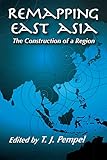Remapping East Asia : The Construction of a Region / ed. by T. J. Pempel.
Material type: TextSeries: Cornell Studies in Political EconomyPublisher: Ithaca, NY : Cornell University Press, [2018]Copyright date: ©2004Description: 1 online resource (334 p.) : 6 graphs/maps, 9 tables, 4 line drawingsContent type:
TextSeries: Cornell Studies in Political EconomyPublisher: Ithaca, NY : Cornell University Press, [2018]Copyright date: ©2004Description: 1 online resource (334 p.) : 6 graphs/maps, 9 tables, 4 line drawingsContent type: - 9780801489099
- 9781501732096
- 337.5 22
- online - DeGruyter
- Issued also in print.
| Item type | Current library | Call number | URL | Status | Notes | Barcode | |
|---|---|---|---|---|---|---|---|
 eBook
eBook
|
Biblioteca "Angelicum" Pont. Univ. S.Tommaso d'Aquino Nuvola online | online - DeGruyter (Browse shelf(Opens below)) | Online access | Not for loan (Accesso limitato) | Accesso per gli utenti autorizzati / Access for authorized users | (dgr)9781501732096 |
Frontmatter -- Contents -- Tables and Figures -- Preface -- Contributors -- 1. Introduction: Emerging Webs of Regional Connectedness -- I. REGIONALISM IN COMPARATIVE PERSPECTIVE -- 2. East Asian Regional Institutions: Characteristics, Sources, Distinctiveness -- 3. Demographic Future of East Asian Regional Integration -- II. DRIVING REGIONAL INTEGRATION -- States -- 4. The Decline of a Japan-led Model of the East Asian Economy -- 5. Why So Many Maps There? Japan and Regional Cooperation -- Corporations -- 6. Between Foreign Direct Investment and Regionalism: The Role of Japanese Production Networks -- 7. The Regionalization of Southeast Asian Business: Transnational Networks in National Contexts -- III. REGIONAL LINKAGES: INSTITUTIONS, INTERESTS, IDENTITIES -- 8. Between Regionalism and Regionalization: Policy Networks and the Nascent East Asian Institutional Identity -- 9. The Political Economy of Environmental Regionalism in Asia -- 10. The War on Terrorism in Asia and the Possibility of Secret Regionalism -- 11. Conclusion: Tentativeness and Tensions in the Construction of an Asian Region -- References -- Index
restricted access online access with authorization star
http://purl.org/coar/access_right/c_16ec
An overarching ambiguity characterizes East Asia today. The region has at least a century-long history of internal divisiveness, war, and conflict, and it remains the site of several nettlesome territorial disputes. However, a mixture of complex and often competing agents and processes has been knitting together various segments of East Asia. In Remapping East Asia, T. J. Pempel suggests that the region is ripe for cooperation rather than rivalry and that recent "region-building" developments in East Asia have had a substantial cumulative effect on the broader canvas of international politics. This collection is about the people, processes, and institutions behind that region-building. In it, experts on the area take a broad approach to the dynamics and implications of regionalism. Instead of limiting their focus to security matters, they extend their discussions to topics as diverse as the mercurial nature of Japan's leadership role in the region, Southeast Asian business networks, the war on terrorism in Asia, and the political economy of environmental regionalism. Throughout, they show how nation-states, corporations, and problem-specific coalitions have furthered regional cohesion not only by establishing formal institutions, but also by operating informally, semiformally, or even secretly.
Issued also in print.
Mode of access: Internet via World Wide Web.
In English.
Description based on online resource; title from PDF title page (publisher's Web site, viewed 02. Mrz 2022)


